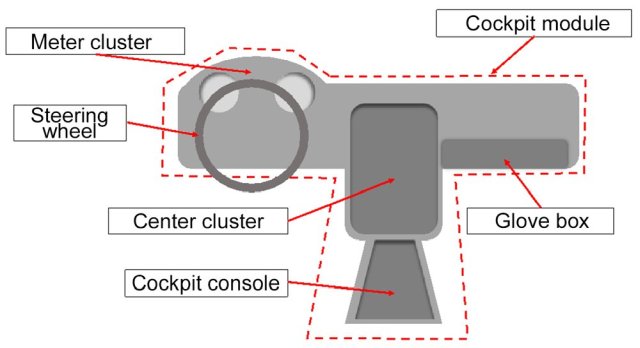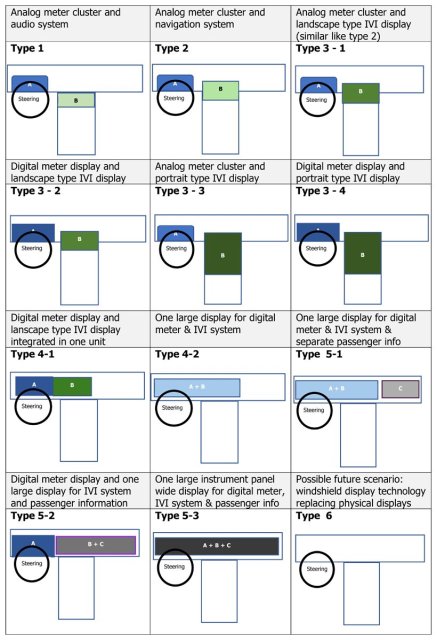Analysis Report: Cockpit Modules (European Market)
Market Trends of Major Suppliers
List of Suppliers
I. Introduction
An automotive cockpit module is an assembly of various key components, such as the instrument panel, center console, floor console, steering wheel, instrument cluster and glove box.
 |
| Key components of the automotive cockpit module (Sketch: Copyright © MarkLines Co., Ltd. All rights reserved) |
The layout and content of the cockpit has changed immensely over the years as new HMI technologies and ADAS systems started entering the market. The conventional, rather simple cockpit, consisting of an instrument panel with instrument cluster, steering wheel, center and floor console with integrated radio and air conditioning, as well as glove box, has disappeared in newly launched European models.
Today's modern connected smart cockpits are far more complex and require advanced human-machine interfaces to enable safe and distraction-free operation.
The evolution of the cockpit layout can be broadly classified into the types shown in the following table:
Types 1 and 2 have almost completely disappeared from the European market. Navigation systems have been replaced by infotainment systems (IVI), and digital driver information displays have replaced traditional analog instrument clusters.
The displays of the IVI systems are either integrated in the center console or float on top of the instrument panel and can be distinguished between portrait-type (vertically aligned) and landscape-type (horizontally aligned).
Type 3 cockpits are still quite common on the European market, but as we will see from the cockpit photos in the following chapters, there is a clear trend toward type 4 and 5 cockpits.
The new models that have recently come onto the market have a tidy cockpit, as the displays are largely integrated into one unit and are all arranged at almost the same height, creating a homogeneous display landscape.Type 6 shows that physical displays might disappear in future cockpits as windshield display technology becomes more advanced.
In addition to the display types described above, head-up displays (HUDs) are becoming increasingly popular. They are mainly used to display driving-related information such as speed, traffic signs, navigation instructions and information provided by advanced driver assistance systems (ADAS). Mainstream and low segment cars are still mainly equipped with combiner-type HUDs, whereas higher segment and premium cars come with higher quality windshield-type HUDs. First vehicles with so called Augmented Reality HUDs, which can significantly enhance the driver’s situational awareness, entered the market as well.
To avoid unnecessary complexity in the drawings of the cockpit scenarios in above table, eventually available HUDs are not shown. HUDs are available in cars with Type 3 cockpit and above. Also eventual touch control panels, which are usually positioned in the center console just below the IVI display or in the floor console, are not shown in the drawings.
If you register as a free member, you can read the rest of this article for a limited time.
In addition, you can also enjoy the following content for free:

 AI Navigator
AI Navigator












 Japan
Japan USA
USA Mexico
Mexico Germany
Germany China (Shanghai)
China (Shanghai) Thailand
Thailand India
India